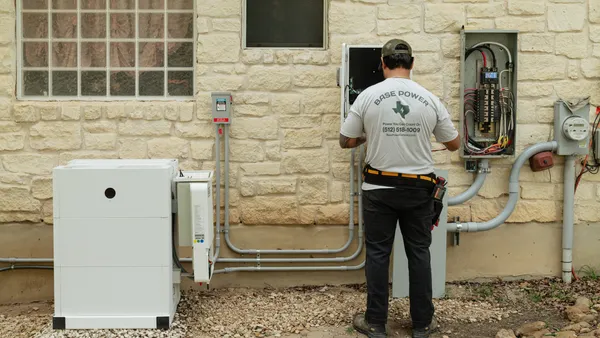Dive Brief:
- The U.S. Energy Storage Association (ESA) is aiming to have 100 GW of new energy storage deployed in the U.S. by the end of this decade, a goal that the association says will produce 200,000 new jobs by 2030.
- Energy storage is "the next great chapter in a story of American energy innovation," Department of Energy (DOE) Deputy Secretary Mark Menezes said at the virtual ESA Energy Storage Annual Conference and Expo on Monday. The DOE is investing heavily in storage research and development, because of its possibilities for grid flexibility and reliability, as well as global competition to develop and deploy these technologies, he said.
- ESA also put out a white paper outlining the path to that 100 GW goal, which includes policy support — like an investment tax credit for standalone storage facilities, as well as efforts to remove barriers to market participation.
Dive Insight:
In 2017, ESA outlined a goal to achieve 35 GW of new energy storage in the U.S. by 2025, including a mix of batteries, pumped hydro and other technologies. In an accompanying report, the association estimated that that goal would lead to $4 billion in cumulative operational cost savings, based on an analysis of the electricity system conducted with Navigant, now Guidehouse.
Storage deployments have slightly lagged compared to that scenario’s projections, however, for several reasons — including tariffs on Chinese goods, the White House executive order on protecting the bulk power system, as well as the COVID-19 pandemic, according to ESA. However, the association also pointed to the Federal Energy Regulatory Commission’s Order 841, issued in 2018, as well as state level policies that have "poised energy storage for accelerated growth in the coming years."
In June, the ESA worked with the American Wind Energy Association, the National Hydropower Association and the Solar Energy Industries Association to establish a "shared vision" wherein 50% of electricity generation in the country would be derived from solar, wind and hydroelectric resources by 2030.
"In a world with policies that support 50% of renewable generation, 100 GW of new storage is entirely likely and probably necessary," Kelly Speakes-Backman, CEO of ESA, said at the conference.
That portfolio will include technologies like batteries, thermal, mechanical and pumped storage hydro.
"100 GW will reduce operating costs of the grid, and therefore lower consumer cost. It’ll avoid outages with increased resiliency and reliability. It’ll improve the air we breathe, and it’ll create about 200,000 new jobs by 2030," she added.
The projection of 200,000 jobs is based on the expectation that 100 GW of new storage will equate to a range of 15 GW to 20 GW of annual installations in 2030, at a rate of 10 jobs per MW installed. But legislative actions are key, according to the white paper — especially a standalone storage ITC.
"This would create an investment signal and facilitate a rush of capital into storage development that would match the demand for storage arising from the clean energy transformation and electrification over the coming decade," the paper states.
Storage could 'fundamentally transform the American energy landscape'
The DOE has invested over $1.2 billion in energy storage research and development activities since 2017, according to Menezes — aimed primarily at making the U.S. the world leader in the storage space. In January, DOE Secretary Dan Brouillette launched the department’s Energy Storage Grand Challenge, which is aimed at accelerating the deployment, commercialization and utilization of next generation storage technologies.
"[T]he department is working to address the challenges we face in realizing the full potential of energy storage technologies," Menezes said. "We are doing so because energy storage has the potential to fundamentally transform the American energy landscape."
But there are challenges to the growth of the sector, including the structure of wholesale markets — which generally do not take into account any of the attributes that the states are trying to drive in terms of procurement, William Acker, executive director of the New York Battery and Energy Storage Technology Consortium, said at the conference. New York, for instance, has a very efficient market, Acker said — but it’s designed around the incumbent structure, rather than to dynamically allow new resources to enter it.
"An example of that is that our capacity auctions are very short term — they’re one month, six month auctions — and it’s very difficult to get any bankable financing around that kind of thing," Acker explained.
Looking at a 70% renewable scenario, you’d have most of these assets not really participating in the market, and instead just being price takers.
"That’s not an efficient market structure, so we believe we have to look at those interactions between state policy and markets," he added.
There are structural elements that block the increased access of new entrants and clean energy resources to markets, Jeremy McDiarmid, vice president of policy and government affairs at the Northeast Clean Energy Council, said — including the focus on reliability and price.
"Our [independent system operators] are so focused on making sure that the lights stay on that they’re undermotivated to experiment with things that make them uneasy. And you couple that with the failure of all of us to plan for what the grid is going to look like in 10 years or beyond, and think about the investments we need to make in infrastructure where the interconnection piece comes in — those two pieces to me are the biggest challenges to the wholesale equation," McDiarmid said.














